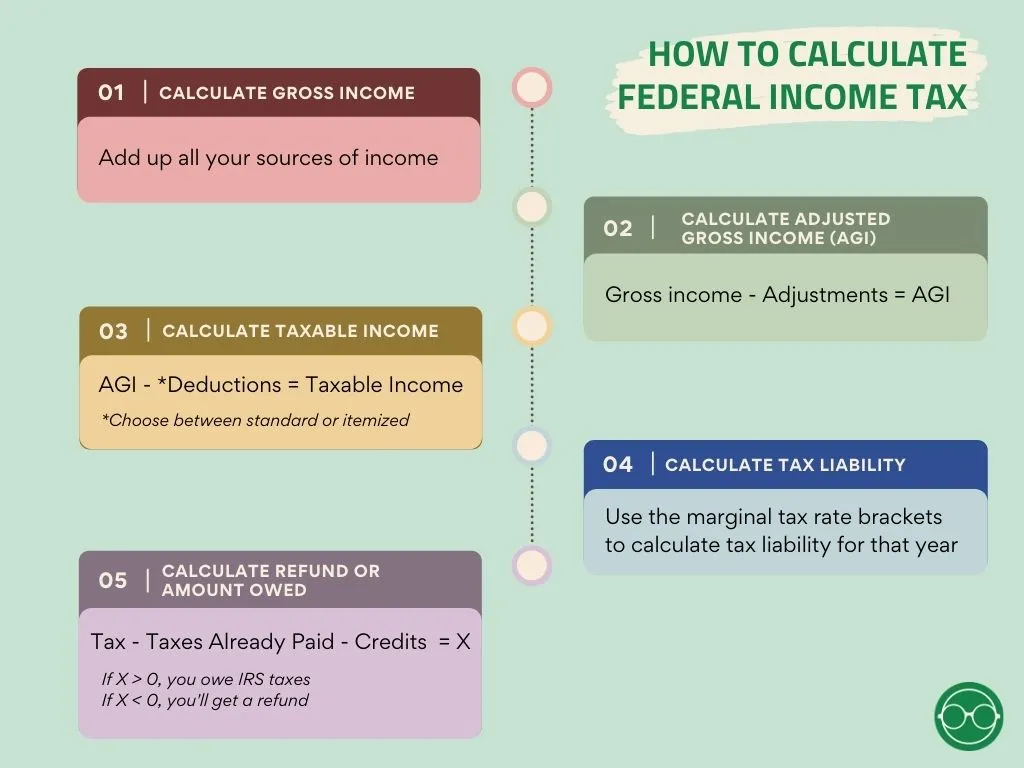This post may contain affiliate links. We may receive compensation when you click on links to those products at no additional cost to you. Read our full disclosure here.
With about 70,000+ pages of “tax code” (including statutes, regulations, and case law), filing your own taxes can seem scary, especially for beginners. However, free resources and technology have made it really easy and we’ll share with you 4 steps on how to file your own taxes in this article.
Why and How To Pay Taxes?
If you make money, the government will want its share of it. You’ll pay taxes throughout the year and then calculate if you underpaid or overpaid taxes when you file your taxes for last year.
There are two ways taxes are paid throughout the year:
- If you’re employed, your employer will take some out of each paycheck and send it to the IRS
- If you’re self-employed, you may need to pay estimated quarterly taxes to the IRS
When you file your taxes for the last year, you are sending tax forms to the IRS to tell them:
- How much money you made.
- What deductions and credits you’re claiming that’ll lower your taxable income so that you’ll pay fewer taxes.
- Their total tax bill.
- How much they underpaid or overpaid for the year.
- If you underpaid, you’ll have to pay the IRS what they are owed
- If you overpaid throughout the year, you’ll receive a tax refund
In essence, you are filing your tax return to see if you are underpaid or overpaid taxes for that tax year.
Do You Need To File Taxes?
If you make less than a certain amount of money, you may not need to file income taxes. However, it is still recommended that you file your tax return as you might qualify for certain tax breaks and credits that will put money in your pockets.
To check if you need to file a tax return, use this tool provided by the IRS.
How To File Your Own Taxes
Now that you know the why and whether you need to file taxes, it’s time to hunker down and get started!
1. Gather Your Info
The first thing you’ll need to do when you file your own taxes is to get organized and gather your tax documents and info in one place. An important tip is to watch for tax documents to arrive in the mail and store them at a place that is convenient and accessible.
| Category | Documents and/or Records | Description |
| Income | W-2 | Employer provided document |
| 1099-NEC | Received from client for freelance or consulting work | |
| 1099-INT | Interest income if you earned more than $10 in interest | |
| 1099-G | Unemployment | |
| Other income | Rental, retirement, any other 1099 received | |
| Adjustments to Income | Form 1098-E | For student loan interests paid |
| Form 1098-T | For tuition paid | |
| Retirement and other savings | Records of IRA, HSA, and other contributions to retirement plans | |
| Alimony paid | Records of alimony paid | |
| Deductions and Credit | Medical and dental expenses | Records of expenses for healthcare and insurance |
| Form 1095-A | If you enrolled in an insurance plan in the marketplace | |
| Charitable donations statement | Cash or non-cash charitable donations | |
| Form 1098 | Mortgage interest and PMI | |
| Childcare expenses | Record of provider’s name, address, tax ID, and amount paid | |
| State and local taxes | Amount of state and local income or sales tax paid, vehicle sales tax paid | |
| Other | Last year's tax return | - |
Note: It is recommended to hold on to your tax records for at least 3 years for any amendments, but I personally am keeping them indefinitely on my computer for peace of mind.
2. Determine Your Tax Filing Status
Once you’ve gathered your tax document and information, you’ll need to determine your tax filing status. Your tax filing status will determine your tax rate, deductions, credits, and ultimately what your tax liability will be. There are 5 types of tax filing status:
- Single: If you’re an unmarried individual, you’ll file as single unless you are covering costs for a dependent.
- Married Filing Jointly (MFJ): Married couples should usually file a joint return to minimize their taxes.
- Access to valuable tax credits like Earned Income Tax Credit (EITC)
- Larger standard deduction
- Larger capital loss deduction
- Combined incomes can potentially bring a higher earner into a lower tax bracket.
- Married Filing Separately (MFS): A married couple who files separately will have a lower standard deduction and lose many tax deductions and benefits.
- Head of Household: Non-married individuals with a qualifying child or dependent can file as head of household to get a higher standard deduction.
- Qualifying widow(er): A widow or widower with a child or dependent gets the MFJ tax benefits if their spouse died within the past two years.
Note: Most tax software will help you determine the best filing status based on the information you input. Don’t stress too much about it!
3. Decide How You Want To File Taxes
There are three main ways to file your taxes:
- Online – Tax preparation software to e-file
- Professional help – CPA, enrolled agent, or VITA
- 100% DIY – Filling out the forms by hand (Personally do not recommend it for beginners as it can get tricky without guidance)
a) Online
The best way to file your taxes is by using online tax preparation software to e-file. My favorite is TurboTax as it is very intuitive and guides you through the entire process easier. It is free for simple tax returns but you’ll have to upgrade if you have more complicated situations like self-employment, investment income, crypto, etc.
For more options, check out the IRS Free File program to have access to other free online tax preparation software. Do note that you must have <$73,000 of adjusted gross income (AGI) to qualify.
Pros of using online tax preparation for tax filing like TurboTax:
- Intuitive: Easy step-by-step guidance for tax filing
- Deductions and credits: Powerful AI that can help you maximize deductions and tax credits
- Accurate: Ensure greater mathematical accuracy as the software will run the numbers
- Flexible: Saves your progress while filing tax return so that you can do it anywhere
- Convenient: Info is stored in the software and can be used to file taxes for future years
- Refund: You can have your refund deposited directly into your bank account
b) Professional
There are three main types of tax professionals who can help you file your taxes:
- Certified Public Accountants (CPA)
- Enrolled Agents
- Tax Attorneys
These professionals are trained and are experts in taxes that can help you in your tax preparation especially if your situation is more complicated.
Pros of working with professionals to file your taxes:
- Knowledgable: Professionals know their stuff and can answer your questions
- Time: Saves you time to do other things as they will prepare your tax return for you
- Strategy: Tax pros can recommend and help implement any tax strategies to help you save more in taxes especially if you have many moving parts
- Peace: Having a pro do it gives you the peace of mind from any screw-ups
- Audit: If you ever get audited by the IRS, they can help you navigate it
4. Understand How Your Taxes Is Calculated
While following the online tax preparation software steps or professional will help you calculate your taxes automatically, it is still crucial to know how your taxes are calculated so that you are aware of how the system works.
See below for an illustration of how your federal taxes are calculated:

Note: The USA uses a progressive tax system to calculate your tax liability. This basically means the higher your income, the more taxes you’ll pay at a higher tax rate. This doesn’t mean that your entire income is taxed at that higher tax rate, instead, your income is separated into levels (aka tax brackets), and each level is taxed only at its respective tax rate. To learn more, watch this video from Vox to see how tax brackets work.
5. Collect Refunds or Pay Taxes
Once you filed your taxes, either online or with a professional, you will probably either have over or underpaid your taxes.
If you underpaid taxes, you owe the IRS money and can pay them through most payment options. The great thing about utilizing online tax preparation software like TurboTax is that you can set up bank withdrawals for payment on the platform.
If you overpaid taxes, congratulations as you will be getting a refund! The quickest way to access your refund is by setting up a direct deposit to your bank account when you file your taxes. You can then track your refund using this IRS tool.
Note: If you are getting a tax refund, read this article to learn what to do with it wisely!
Summary
Learning how to file your own taxes is not hard with the free resources and online tax preparation software available. If your situation is more complicated, it may be wise to consult a professional to save time and potentially money as well. Be sure to know at least the basics of how your taxes are calculated so that you have a solid foundation to build upon. Last but not least, don’t forget to file your taxes before the deadline (typically in mid-April)!
This post may contain affiliate links. We may receive compensation when you click on links to those products at no additional cost to you. Read our full disclosure here.






